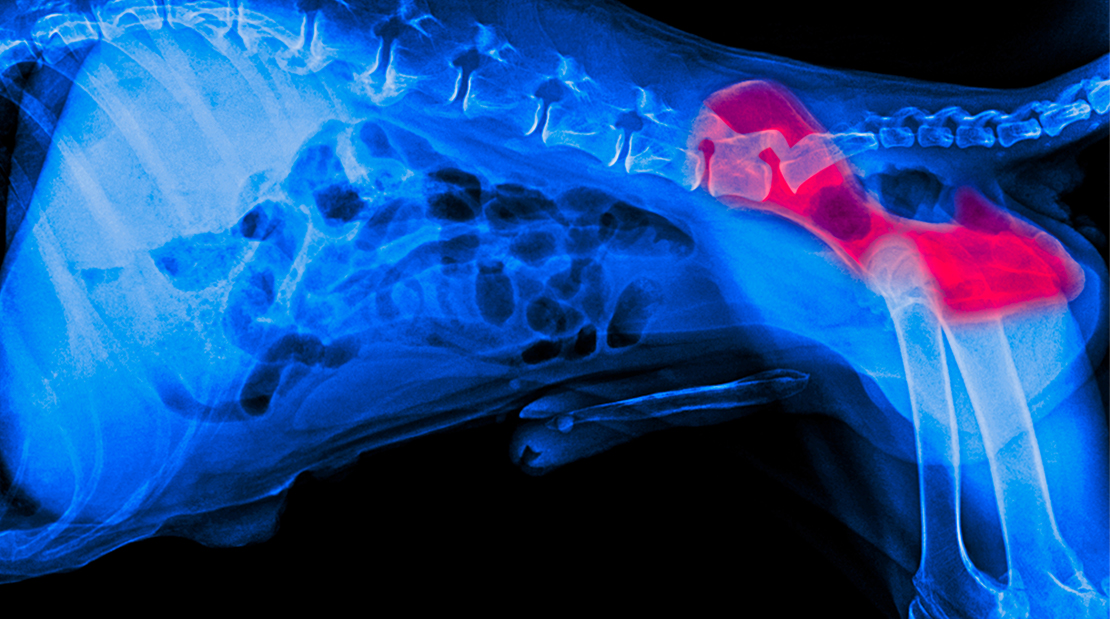
Hip Dysplasia
Hip dysplasia is a painful condition that affects the functioning of hip joints. The condition, mostly caused by genetics, can be found in both humans and animals. When it comes to our pets, we see the deformity in dogs and cats. Pet parents concerned about hip dysplasia can partner with their veterinarian to determine a treatment plan. But before diving into the condition, let’s first discuss the hip bone and how it operates under normal conditions.
Hip joints and the ball and socket
The hip joint is where the pelvis and the thigh bone merge, which then operates as a “ball and socket”. Ball and socket joints allow the highest range of movement in the body. In humans, another example of a ball and socket joint is where the arm meets the shoulder blade. With the hip joint, the “ball” is the top of the thigh bone, medically known as the femur. The socket, where the ball sits, is provided by the pelvis.
Under normal conditions, the leg has freedom of movement while still sitting the pelvic socket. With hip dysplasia, the hip joint becomes dislocated.
Causes of Hip Dysplasia
Hip dysplasia is mostly hereditary. We typically see the condition in large dog breeds such as rottweilers, german shepherds, and mastiffs. Large breeds have excessive growth rates that can put a strain on joints at the early stages of the lives. For example, rottweilers, born weighing an average of two pounds, grow to weigh up to 60 pounds in less than six months.
Smaller dog breeds and cats can also suffer from hip dysplasia. This is often attributed to obesity, which is a leading cause of many preventable diseases and shortened life spans. Extra weight on dogs and cats put unnecessary stress on their bones and joints. In addition to hip dysplasia, pet obesity can also lead to osteoarthritis and other chronic pain conditions.
Signs and Symptoms
While puppies and kittens can display signs of hip dysplasia at birth, the condition typically presents itself within 4-6 months. Here are some symptoms of hip dysplasia in dogs:
- Limping
- Decreased activity
- Decreased range of motion
- Difficulty or reluctance to rise or jump
- Lack of balance when standing
- One leg appearing to be longer or shorter than the other
Hip dysplasia tends to be more apparent in dogs than cats. By nature, cats are less likely to show signs of pain or limit their activity to avoid painful movement. Symptoms of hip dysplasia in cats include:
- Lethargy
- Irritability
- Limited movement
Pain management, treatment, and care
While hip dysplasia is painful and can affect our pet’s quality of life.
Pain management can include:
- Aspirin
- Anti-inflammatory supplements
- Joint and muscle massages
Hip Dysplasia care
Some dogs or cats with hip dysplasia may benefit from a:
- Pet wheelchair
- Hip replacements
- Physical therapy
Prevention
Hip dysplasia is most commonly an inherited disease, making the condition hard to prevent. Pet parents of larger dogs can ask breeders for their pet’s history and obtain documentation certifying the health their dog’s hips.
Prevention of hip dysplasia due to obesity includes monitoring your pet’s nutrition for weight management and reduction when necessary.
A diagnosis of hip dysplasia can be frightening for pet parents. With the right course of action, however, both parents and pets can navigate through this condition. For more questions about hip dysplasia, contact the Cy-Fair Animal Hospital team on Facebook, Twitter, or phone.

